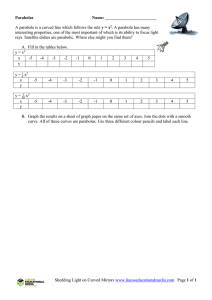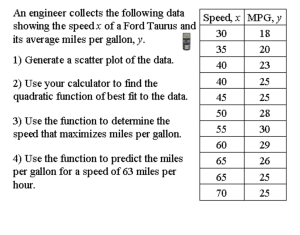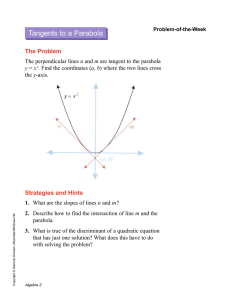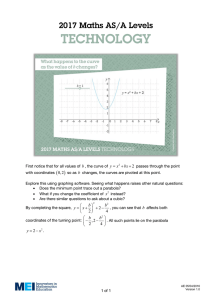1 Geometry 1.1
advertisement
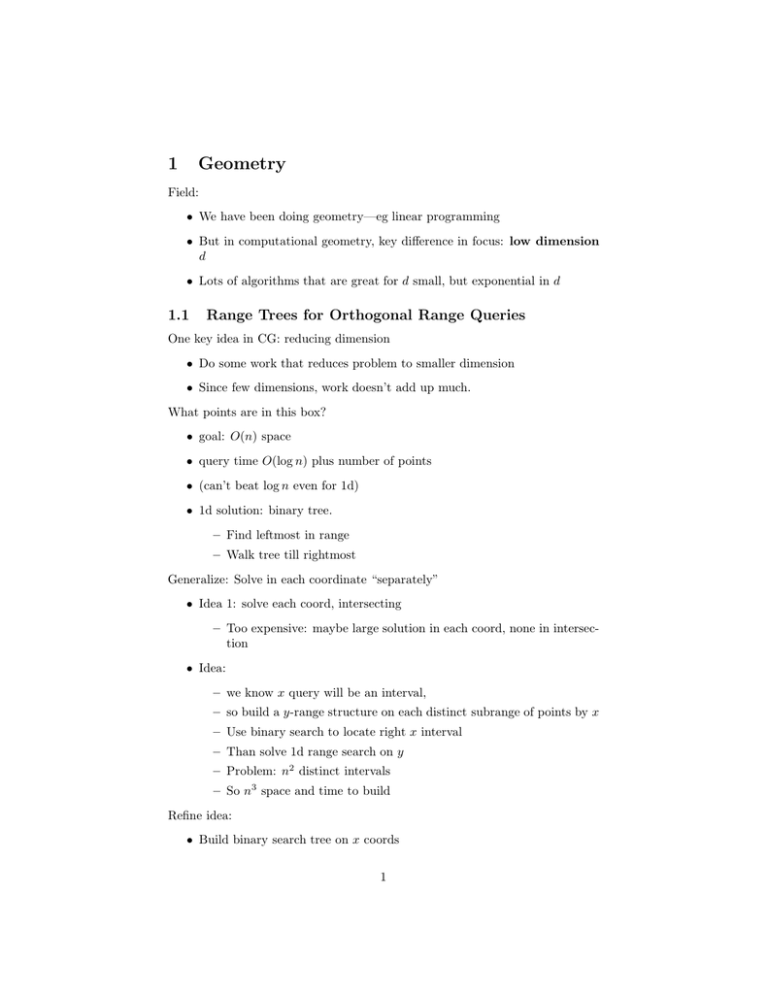
1 Geometry Field: • We have been doing geometry—eg linear programming • But in computational geometry, key difference in focus: low dimension d • Lots of algorithms that are great for d small, but exponential in d 1.1 Range Trees for Orthogonal Range Queries One key idea in CG: reducing dimension • Do some work that reduces problem to smaller dimension • Since few dimensions, work doesn’t add up much. What points are in this box? • goal: O(n) space • query time O(log n) plus number of points • (can’t beat log n even for 1d) • 1d solution: binary tree. – Find leftmost in range – Walk tree till rightmost Generalize: Solve in each coordinate “separately” • Idea 1: solve each coord, intersecting – Too expensive: maybe large solution in each coord, none in intersection • Idea: – we know x query will be an interval, – so build a y-range structure on each distinct subrange of points by x – Use binary search to locate right x interval – Than solve 1d range search on y – Problem: n2 distinct intervals – So n3 space and time to build Refine idea: • Build binary search tree on x coords 1 • Each internal node represents an interval containing some points • Our query’s x interval can be broken into O(log n) tree intervals • We want to reduce dimension: on each subinterval, range search y coords only amound nodes in that x interval • Solution: each internal node has a y-coord search tree on points in its subtree • Size: O(n log n), since each point in O(log n) internal nodes • Query time: find O(log n) nodes, range search in each y-tree, so O(log2 n) (plus output size) • more generally, O(logd n) • fractional cascading improves to O(log n) Dynamic maintenance: • Want to insert/delete points • Problem to maintain tree balance • When insert x coord, may want to rebalance • Rotations are obious choice, but have to rebuild auxiliary structures • Linear cost to rotate a tree. • Remember treaps? – We showed expect 1 rotation – Can show expected size of rotated tree is small – Then insert y coord in O(log n) auxiliary structures – So, O(log2 n) update cost 2 Sweep Algorithms Another key idea: • dimension is low, • so worth expending lots of energy to reduce dimension • plane sweep is a general-purpose dimension reduction • Run a plane/line across space • Study only what happens on the frontier • Need to keep track of “events” that occur as sweep line across • simplest case, events occur when line hits a feature 2 2.1 Convex Hull by Sweep Line • define • good for: width, diameter, filtering • assume no 3 points on straight line. • output: – points and edges on hull – in counterclockwise order – can leave out edges by hacking implementation • Ω(n log n) lower bound via sorting Build upper hull: • Sort points by x coord • Sweep line from left to right • maintain upper hull “so far” • as encounter next point, check if hull turns right or left to it • if right, fine • if left, hull is concave. Fix by deleting some previous points on hull. • just work backwards till no left turn. • Each point deleted only once, so O(n) • but O(n log n) since must sort by x coord. 2.2 Halfspace intersection Duality. • (a, b) → ax + by + 1 = 0. • line through two points becomes point at intersection of 2 lines • point at distance d antipodal line at distance 1/d. • intersection of halfspace become convex hull. So, O(n log n) time. 3 2.3 Segment intersections We saw this one using persistent data structures. • Maintain balanced search tree of segments ordered by current height. • Heap of upcoming “events” (line intersections/crossings) • pull next event from heap, output, swap lines in balanced tree • check swapped lines against neighbors for new intersection events • lemma: next event always occurs between neighbors, so is in heap • note: next event is always in future (never have to backtrack). • so sweep approach valid • and in fact, heap is monotone! 3 Voronoi Diagram Goal: find nearest MIT server terminal to query point. Definitions: • point set p • V (pi ) is space closer to pi than anything else • for two points, V (P ) is bisecting line • For 3 points, creates a new “voronoi” point • And for many points, V (pi ) is intersection of halfplanes, so a convex polyhedron • And nonempty of course. • but might be infinite • Given VD, can find nearest neighbor via planar point location: • O(log n) using persistent trees Space complexity: • VD is a planar graph: no two voronoi edges cross (if count voronoi points) • add one point at infinity to make it a proper graph with ends • Euler’s formula: nv − ne + nf = 2 4 • (nv is voronoi points, not original ones) • But nf = n • Also, every voronoi point has degree at least 3 while every edge has two endpoints. • Thus, 2ne ≥ 3(nv + 1) • rewrite 2(n + nv − 2) ≥ 3(nv + 1) • So n − 2 ≥ (nv + 3)/2, ie nv ≤ 2n − 7 • Gives ne ≤ 3n − 6 Summary: V (P ) has linear space and O(log n) query time. 3.1 Construction VD is dual of projection of lower CH of lifting of points to parabola in 3D. And 3D CH can be done in O(n log n) Can build each vornoi cell in O(n log n), so O(n2 log n). 3.2 Plane Sweep Basic idea: • Build portion of Vor behind sweep line. • problem: not fully determined! may be about to hit a new site. • What is determined? Stuff closer to a point than to line • boundary is a parabola • boundary of know space is pieces of parabolas: “beach line” • as sweep line descends, parabolas descend too. • We need to maintain beach line as “events” change it Descent of one parabola: • sweep line (horizontal) y coord is t • Equation (x − xf )2 + (y − yf )2 = (y − t)2 . • Fix x, find dy/dt • 2(y − yf )dy/dt = 2(y − t)(dy/dt − 1) • So dy/dt = −(y − t)/(y − yf ) 5 • Thus, the higher yf (farther from sweep line) the slower parabola descends. Site event: • Sweep line hits site • creates new degenerate parabola (vertical line) • widens to normal parabola • adds arc piece to beach line. Claim: no other create events. • case 1: one parabola passing through one other – At crossover, two parabolas are tangent. – then “inner” parabola has higher focus then outer – so descends slower – so outer one stays ahead, no crossover. • case 2: new parabola descends through intersection point of two previous parabolas. – At crossover, all 3 parabolas intersect – thus, all 3 foci and sweep line on boundary of circle with intersection at center. – called circle event – “appearing” parabola has highest focus – so it is slower: won’t cross over – In fact, this is how parabola’s disappear from beach line – outer parabolas catch up with, cross inner parabola. Summary: • only site events add to beach line • only circle events remove from beach line. • n site events • so only n circle events • as insert/remove events, only need to check for events in newly adjacent parabolas • so O(n log n) time 6 4 Randomized Incremental Constructions BSP • linearity of expectation. hat check problem • Rendering an image – render a collection of polygons (lines) – painters algorithm: draw from back to front; let front overwrite – need to figure out order with respect to user • define BSP. – BSP is a data structure that makes order determination easy – Build in preprocess step, then render fast. – Choose any hyperplane (root of tree), split lines onto correct side of hyperplane, recurse – If user is on side 1 of hyperplane, then nothing on side 2 blocks side 1, so paint it first. Recurse. – time=BSP size • sometimes must split to build BSP • how limit splits? • autopartitions • random auto • analysis – index (u, v) = k if k lines block v from u – u v if v cut by u auto – probability 1/(1 + index (u, v)). – tree size is (by linearity of E) � n+ 1/index (u, v) ≤ � 2Hn u • result: exists size O(n log n) auto • gives randomized construction • equally important, gives probabilistic existence proof of a small BSP • so might hope to find deterministically. 7 Backwards Analysis—Convex Hulls Define. algorithm (RIC): • random order pi • insert one at a time (to get Si ) • update conv(Si−1 ) → conv(Si ) – new point stretches convex hull – remove new non-hull points – revise hull structure • Data structure: – point p0 inside hull (how find?) – for each p, edge of conv(Si ) hit by p0 p – say p cuts this edge • To update pi in conv(Si−1 ): – if pi inside, discard – delete new non hull vertices and edges – 2 vertices v1 , v2 of conv(Si−1 ) become pi -neighbors – other vertices unchanged. • To implement: – detect changes by moving out from edge cut by p0 p. – for each hull edge deleted, must update cut-pointers to piv1 or piv2 Runtime analysis • deletion cost of edges: – charge to creation cost – 2 edges created per step – total work O(n) • pointer update cost – proportional to number of pointers crossing a deleted cut edge – BACKWARDS analysis ∗ run backwards ∗ delete random point of Si (not conv(Si )) to get Si−1 8 ∗ same number of pointers updated ∗ expected number O(n/i) · what Pr[update p]? · Pr[delete cut edge of p] · Pr[delete endpoint edge of p] · 2/i ∗ deduce O(n log n) runtime • 3d convex hull using same idea, time O(n log n), 4.1 Linear Programming • define • assumptions: – nonempty, bounded polyhedron – minimizing x1 – unique minimum, at a vertex – exactly d constraints per vertex • definitions: – hyperplanes H – basis B(H) – optimum O(H) • Simplex – exhaustive polytope search: – walks on vertices – runs in O(nd/2 ) time in theory – often great in practice • polytime algorithms exist, but bit-dependent! • OPEN: strongly polynomial LP • goal today: polynomial algorithms for small d Randomized incremental algorithm T (n) ≤ T (n − 1, d) + d (O(dn) + T (n − 1, d − 1)) = O(d!n) n 9 Trapezoidal decomposition: Motivation: • manipulate/analayze a collection of n segments • assume no degeneracy: endpoints distinct • (simulate touch by slight crossover) • e.g. detect segment intersections • e.g., point location data structure • Basic idea: – Draw verticals at all points and intersects – Divides space into slabs – binary search on x coordinate for slab – binary search on y coordinate inside slab (feasible since lines noncrossing) – problem: Θ(n2 ) space Definition. • draw altitudes from each endpoints and intersection till hit a segment. • trapezoid graph is planar (no crossing edges) • each trapezoid is a face • show a face. • one face may have many vertices (from altitudes that hit the outside of the face) • but max vertex degree is 6 (assuming nondegeneracy) • so total space O(n + k) for k intersections. • number of faces also O(n+ k) (at least one edge/face, at most 2 face/edge) • (or use Euler’s theorem: nv − ne + nf ≥ 2) • standard clockwise pointer representation lets you walk around a face Randomized incremental construction: • to insert segment, start at left endpoint • draw altitudes from left end (splits a trapezoid) • traverse segment to right endpoint, adding altitudes whenever intersect 10 • traverse again, erasing (half of) altitudes cut by segment Implementation • clockwise ordering of neighbors allows traversal of a face in time proportional to number of vertices • for each face, keep a (bidirectional) pointer to all not-yet-inserted leftendpoints in face • to insert line, start at face containing left endpoint • traverse face to see where leave it • create intersection, – update face (new altitude splits in half) – update left-end pointers • segment cuts some altititudes: destroy half – removing altitude merges faces – update left-end pointers – (note nonmonotonic growth of data structure) Analysis: • Overall, update left-end-pointers in faces neighboring new line • time to insert s is � (n(f ) + (f )) f ∈F (s) where – F (s) is faces s bounds after insertion – n(f ) is number of vertices on face f boundary – (f ) is number of left-ends inside f . • So if Si is first i segments inserted, expected work of insertion i is 1 � � (n(f ) + (f )) i s∈Si f ∈F (s) • Note each f appears at most 4 times in sum since at most 4 lines define each trapezoid. � • so O( 1i f (n(f ) + (f ))). • Bound endpoint contribution: 11 – note � f (f ) = n − i – so contributes n/i – so total O(n log n) (tight to sorting lower bound) • Bound intersection contribution � – n(f ) is just number of vertices in planar graph – So O(ki + i) if ki intersections between segments so far – so cost is E[ki ] – intersection present if both segments in first i insertions – so expected cost is O((i2 /n2 )k) – so cost contribution (i/n2 )k – sum over i, get O(k) – note: adding to RIC, assumption that first i items are random. • Total: O(n log n + k) Search structure Starting idea: • extend all vertical lines infinitely • divides space into slabs • binary search to find place in slab • binary search in slab feasible since lines in slab have total order • O(log n) search time Goal: apply binary search in slabs, without n2 space • Idea: trapezoidal decom is “important” part of vertical lines • problem: slab search no longer well defined • but we show ok The structure: • A kind of search tree • “x nodes” test against an altitude • “y nodes” test against a segment • leaves are trapezoids • each node has two children 12 • But may have many parents Inserting an edge contained in a trapezoid • update trapezoids • build a 4-node subtree to replace leaf Inserting an edge that crosses trapezoids • sequence of traps ∆i • Say ∆0 has left endpoint, replace leaf with x-node for left endpoint and y-node for new segment • Same for last ∆ • middle ∆: – each got a piece cut off – cut off piece got merged to adjacent trapezoid – Replace each leaf with a y node for new segment – two children point to appropriate traps – merged trap will have several parents—one from each premerge trap. Search time analysis • depth increases by one for new trapezoids • RIC argument shows depth O(log n) – Fix search point q, build data structure – Length of search path increased on insertion only if trapezoid containing q changes – Odds of top or bottom edge vanishing (backwards analysis) are 1/i – Left side vanishes iff unique segment defines that side and it vanishes – So prob. 1/i – Total O(1/i) for ith insert, so O(log n) overall. 13
